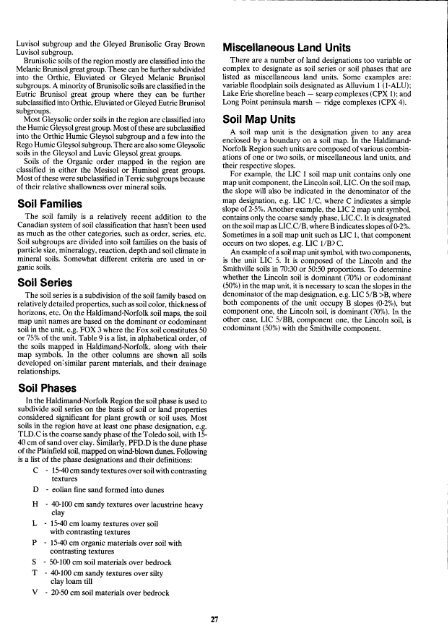Soil Report - Agriculture et Agroalimentaire Canada
Soil Report - Agriculture et Agroalimentaire Canada
Soil Report - Agriculture et Agroalimentaire Canada
Create successful ePaper yourself
Turn your PDF publications into a flip-book with our unique Google optimized e-Paper software.
Luvisol subgroup and the Gleyed Brunisolic Gray Brown<br />
Luvisol subgroup .<br />
Brunisolic soils of the region mostly are classified into the<br />
Melanic Brunisol great group . These can be further subdivided<br />
into the Orthic, Eluviated or Gleyed Melanic Brunisol<br />
subgroups . A minority of Brunisolic soils are classified in the<br />
Eutric Brunisol great group where they can be further<br />
subclassified into Orthic, Eluviated or Gleyed Eutric Brunisol<br />
subgroups.<br />
Most Gleysolic order soils in the region are classified into<br />
the Humic Gleysol greatgroup. Most ofthese are subclassified<br />
into the Orthic Humic Gleysol subgroup and a few into the<br />
Rego Humic Gleysol subgroup . There are also some Gleysolic<br />
soils in the Gleysol and Luvic Gleysol great groups .<br />
<strong>Soil</strong>s of the Organic order mapped in the region are<br />
classified in either the Mesisol or Humisol great groups.<br />
Most of these were subclassified in Terric subgroups because<br />
of their relative shallowness over mineral soils .<br />
<strong>Soil</strong> Families<br />
The soil family is a relatively recent addition to the<br />
Canadian system of soil classification that hasn't been used<br />
as much as the other categories, such as order, series, <strong>et</strong>c.<br />
<strong>Soil</strong> subgroups are divided into soil families on the basis of<br />
particle size, mineralogy, reaction, depth and soil climate in<br />
mineral soils . Somewhat different criteria are used in organic<br />
soils.<br />
<strong>Soil</strong> Series<br />
The soil series is a subdivision of the soil family based on<br />
relatively d<strong>et</strong>ailed properties, such as soil color, thickness of<br />
horizons, <strong>et</strong>c. On the Haldimand-Norfolk soil maps, the soil<br />
map unit names are based on the dominant or codominant<br />
soil in the unit, e .g . FOX 3 where the Fox soil constitutes 50<br />
or 75% of the unit. Table 9 is a list, in alphab<strong>et</strong>ical order, of<br />
the soils mapped in Haldimand-Norfolk, along with their<br />
map symbols . In the other columns are shown all soils<br />
developed on'similar parent materials, and their drainage<br />
relationships .<br />
<strong>Soil</strong> Phases<br />
In the Haldimand-Norfolk Region the soil phase is used to<br />
subdivide soil series on the basis of soil or land properties<br />
considered significant for plant growth or soil uses . Most<br />
soils in the region have at least one phase designation, e .g .<br />
TLD.C is the coarse sandy phase of the Toledo soil, with 15-<br />
40 cm of sand over clay . Similarly, PFD.D is the dune phase<br />
of the Plainfield soil, mapped on wind-blown dunes. Following<br />
is a list of the phase designations and their definitions :<br />
C - 15-40 cmsandy textures over soilwith contrasting<br />
textures<br />
D - eolian fine sand formed into dunes<br />
H - 40-100 cm sandy textures over lacustrine heavy<br />
clay<br />
L - 15-40 cm loamy textures over soil<br />
with contrasting textures<br />
P - 15-40 cm organic materials over soil with<br />
contrasting textures<br />
S - 50-100 cm soil materials over bedrock<br />
T - 40-100 cm sandy textures over silty<br />
clay loam till<br />
V - 20-50 cm soil materials over bedrock<br />
Miscellaneous Land Units<br />
There are a number of land designations too variable or<br />
complex to designate as soil series or soil phases that are<br />
listed as miscellaneous land units . Some examples are :<br />
variable floodplain soils designated as Alluvium 1 (1-ALU) ;<br />
Lake Erie shoreline beach - scarp complexes (CPX 1) ; and<br />
Long Point peninsula marsh - ridge complexes (CPX 4) .<br />
<strong>Soil</strong> Map Units<br />
A soil map unit is the designation given to any area<br />
enclosed by a boundary on a soil map . In the Haldimand-<br />
Norfolk Region such units are composed of various combinations<br />
of one or two soils, or miscellaneous land units, and<br />
their respective slopes.<br />
For example, the LIC 1 soil map unit contains only one<br />
map unit component, the Lincoln soil, LIC . On the soil map,<br />
the slope will also be indicated in the denominator of the<br />
map designation, e .g . LIC 1/C, where C indicates a simple<br />
slope of 2-5% . Another example, the LIC 2 map unit symbol,<br />
contains only the coarse sandy phase, LIC.C . It is designated<br />
on the soil map as LIC .C/B, where B indicates slopes of0-2% .<br />
Som<strong>et</strong>imes in a soil map unit such as LIC 1, that component<br />
occurs on two slopes, e .g . LIC 1/B>C .<br />
An example ofa soil map unit symbol, with two components,<br />
is the unit LIC 5. It is composed of the Lincoln and the<br />
Smithville soils in 70 :30 or 50:50 proportions . To d<strong>et</strong>ermine<br />
wh<strong>et</strong>her the Lincoln soil is dominant (70%) or codominant<br />
(50%) in the map unit, it is necessary to scan the slopes in the<br />
denominator of the map designation, e .g . LIC 5/B >B, where<br />
both components of the unit occupy B slopes (0-2%), but<br />
component one, the Lincoln soil, is dominant (70%) . In the<br />
other case, LIC 5/BB, component one, the Lincoln soil, is<br />
codominant (50%) with the Smithville component .

















